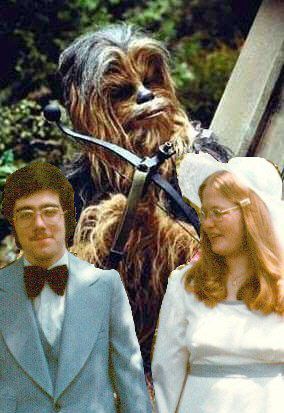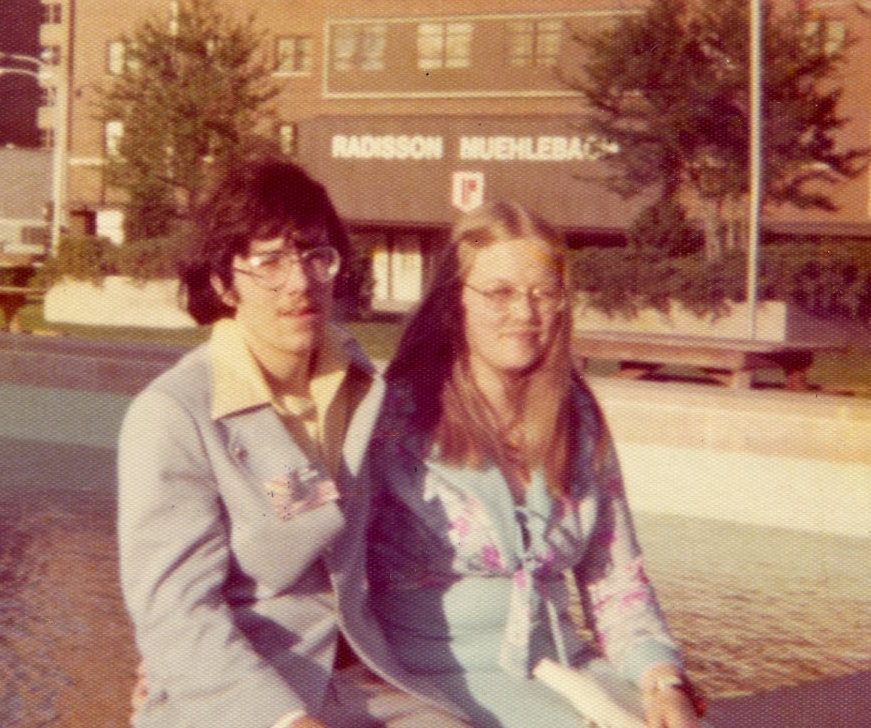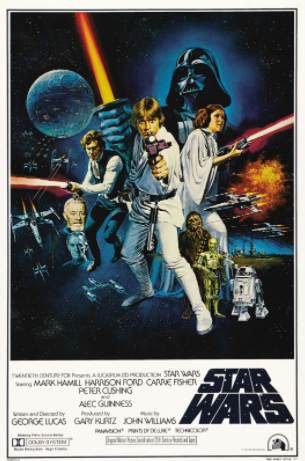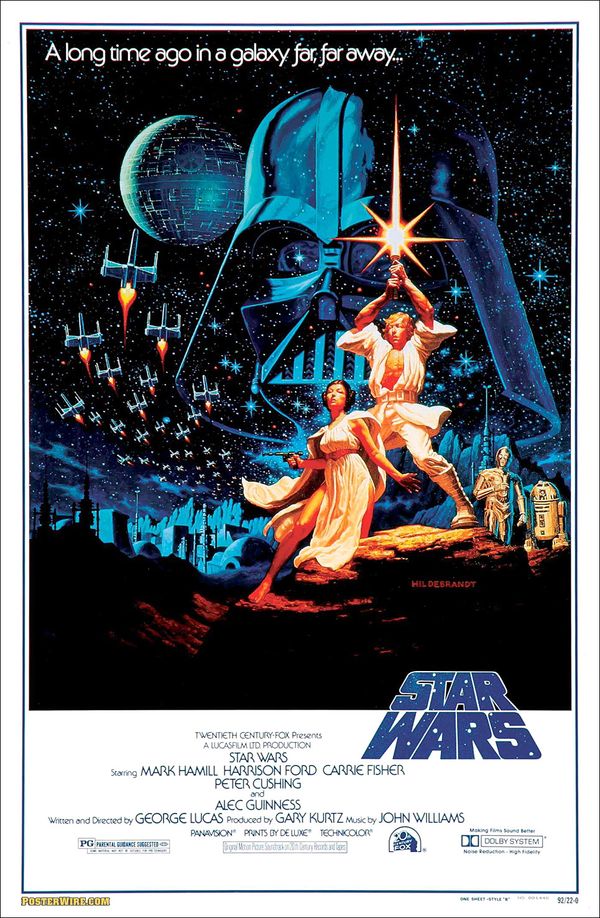Honeymooning with Wookiees - A Star Wars Story (sort of)
Laurie D. T. Mann
Originally Published in Collision (University of Pittsburgh), Spring 2001

While my husband, Jim, may be the only man in America who can recite his wedding anniversary date without any wifely intervention, he calculates the date in a truly unique manner: "Star Wars premiered on Wednesday, May 25, 1977. We got married three days before that; so, we must have gotten married on Sunday, May 22, 1977."
I am not making this up. My husband has always remembered the date of the Star Wars premiere more readily than that of his own wedding. It's very strange, because neither of us have generally paid attention to popular trends. We might have been in college during the '70s, but we hated disco passionately and anything else that was even marginally trendy.
We even met at the least trendy location of 1975 -- at a science fiction club meeting. When most people heard the term "sci-fi fan," they thought of pale, glassy-eyed, pimply adolescent boys with Mr. Spock pointy ears and a plastic pocket protector filled with ballpoints. Now, it's true that there was (and still is) a subset of fans who fit that description, though usually the ones with the plastic pocket protectors are generally not wearing Spock ears at the same time. But most of us, while pale and maybe pimply, wouldn't be caught dead with pointed ears or pocket protectors; we just read science fiction and talked incessantly. We loved the robots of Issac Asimov, the world-building of Frank Herbert, and gender-bending of Ursula K. Le Guin. We spent many hours in conversation over books, computer kits (back in the '70s, you had to mail order the pieces for a primitive computer and assemble it yourself), movies, getting to Mars by the end of the century, and getting to the next convention by the end of next month.
I met Jim when he was a junior at Carnegie Mellon University and I was a wide-eyed freshman. He was of medium height, medium weight, with a mass of black hair, hazel eyes, glasses and a moustache. He looked so Black-Irish I practically expected him to break out in "Oh Danny Boy," but any musical ability missed his branch of the family. Other than the glasses, we shared no physical characteristics at all, as I was more of a mushy Nordic type. He tended to be quiet and bookish -- one of the smartest people I'd ever met. No one has ever accused me of being quiet.
While Jim was quiet in groups of more than two, I had some great conversations with him alone. We started talking at club meetings and conventions. Eventually, we started having two-hour long phone conversations, ending only when one of Jim's younger brothers took the phone away by force. At first, we had nothing in common other than a mutual love of reading. Jim and I were from wholly different backgrounds, religious upbringings, and parts of the country. I was living on campus, and he was commuting to college from his home. But, the more we kept talking, the more we found we had in common. We both loved the films of Mel Brooks and Stanley Kubrick; in fact, going to see Barry Lyndon was our first real date. We both hated the Bee Gees (who later scored Saturday Night Fever) and Donna Summer (the "Disco Queen") and loved the Moody Blues and the Beatles. Within a few weeks, we realized it wasn't just the conversation we loved, it was each other. By the end of my freshman year, Jim and I were engaged and were planning to get married after Jim's graduation in May 1977.
So we bucked another '70s trend -- we planned to get married in our very early twenties without a job, a house, a car or even our own TV. To save money during the next school year, Jim continued living at home and I shared an apartment with three other women (one of whom is now known as the science fiction writer Brenda Clough). We never registered anywhere while we were engaged, because we needed everything, and we had high hopes of getting usefulhouse wares. We did not need or want a metal ice bucket with matching tongs or a fondue set; we got both anyway. Despite our anti-trendy natures, our honeymoon landed smack in the middle of one of the biggest fads of the late '70s. There was no way to avoid Star Wars, even if we wanted to.
 Our first exposure to Star Wars took place the year before the movie came out. Over Labor Day weekend of 1976, Jim and I went to Kansas City, MO to attend the World Science Fiction Convention. The Worldcon was, in the '70s, the largest SF con of the year. Nearly 3,000 science fiction fans, writers, artists and publishers invaded the city, just three weeks after the Republican National Convention had taken over the city to nominate Gerald Ford as its candidate for president. Downtown hadn't quite recovered from that onslaught of middle-aged, upper-middle class Americans yet. "Welcome, Republicans" signs still adorned many downtown shops and many of the exhausted hotel, shop and restaurant employees were on vacation.
Our first exposure to Star Wars took place the year before the movie came out. Over Labor Day weekend of 1976, Jim and I went to Kansas City, MO to attend the World Science Fiction Convention. The Worldcon was, in the '70s, the largest SF con of the year. Nearly 3,000 science fiction fans, writers, artists and publishers invaded the city, just three weeks after the Republican National Convention had taken over the city to nominate Gerald Ford as its candidate for president. Downtown hadn't quite recovered from that onslaught of middle-aged, upper-middle class Americans yet. "Welcome, Republicans" signs still adorned many downtown shops and many of the exhausted hotel, shop and restaurant employees were on vacation.
No one confused us with Republicans though. We science fiction fans were mostly young and favored long hair, blue jeans and silly T-shirts. At three in the morning, the only open coffee shop in downtown was filled with fans, cops, and hookers -- cops mostly ignored us. The hookers, though, were decidedly unhappy with us. Turns out they got little business from us; we weren't a group that ever had to pay for sex (unlike the Republicans, apparently).
Jim and I wandered around the Muehlbach, the grand old hotel where the Worldcon took place. It was a scene of "cultural disconnect" -- people talking about L5 in '95 (a project promoting a large commercial space station at Lagrange point 5 by 1995) and about the future of space travel in function rooms decorated with velveteen wallpaper, electric candle sconces and faux Louis XIV furniture. We spent many hours in the book dealer's room, Jim's favorite convention haunt, where about 250 booksellers had thousands of new, used, and rare books for sale. I particularly enjoyed the art show, with its varied display of the science fiction and fantasy paintings.
"Hey, let's try to find the room with the movie exhibit," Jim suggested. "I think it's down this hallway over here."
We wandered into the out-of-the way ballroom and found about forty black and white photographs on the wall. "Who are these people?" I asked, looking at some of the pictures of the cast. "I've heard of Carrie Fisher -- her mom is Debbie Reynolds -- but who is Harrison Ford?"
"No idea... I've never heard of Mark Hamill either." It turned out Hamil was so anonymous in September 1976 that he was even at the Worldcon and no one noticed.
"He looks too short to be a space hero. And what's this giant bear with a laser?" I asked.
"Probably some alien."
"I know that, but a giant, furry bear? That just seems way too hokey. It looks like they don't take SF at all seriously. It looks like something out of Buck Rogers"
"Or Duck Dodgers." Jim laughed.
"Oh great. I just want a serious science fiction movie for a change. Not another Sleeper. Not another Young Frankenstein. Just something that's both science fictional and serious."
Jim zeroed in on the spaceship models, in clear plastic cubes in the center of the room. These models lacked the sleekness of typical movie spaceships. They had all kinds of indentations of protrusions. "The ships look pretty good though. Hollywood always forgets that ships in space can be any shape, they don't have to look like airplanes or rockets," he said.
"Yeah, but no one's done decent space ships or special effects since 2001, A Space Odyssey. Now that was a science fiction movie for adults. It wasn't silly. Star Wars looks like it's gonna be for kids."
Before we left the movie exhibit, a suited young man (obviously a studio flunky, no one else wore suits to SF cons) gave us copies of the preliminary poster. The initial poster was very purple, with characters fighting with shocking pink swords. Weird.
 [Parenthetical remark from 2017 - This poster is showing up as a Star Wars poster from 1976 online. However this was not the poster they gave out at MidAmeriCon 76. There were definitely characters having a light saber fight in the background and Chewie was a bit more prominent. If anyone can supply a scan of the 1976 Star Wars poster that was distributed at MidAmeriCon, please send me one.]
[Parenthetical remark from 2017 - This poster is showing up as a Star Wars poster from 1976 online. However this was not the poster they gave out at MidAmeriCon 76. There were definitely characters having a light saber fight in the background and Chewie was a bit more prominent. If anyone can supply a scan of the 1976 Star Wars poster that was distributed at MidAmeriCon, please send me one.]
I didn't hold out much hope that Star Wars would be any good. Not that I worried about it much. We were busy with school and planning our wedding -- not overly concerned about a movie whose premiere was a year away. But along about Thanksgiving, we started seeing posters for the movie in theaters. They were radically different from the poster we'd seen the previous summer. Skinny Mark Hamill had a pumped-up chest, biceps, and his shirt was split down to the navel. Short Carrie Fisher looked tall and willowy with her flowing white dress split almost up to the navel. Harrison Ford and the giant hairy bear were nowhere to be seen.
 We stared at the poster in amazement. "I hate when the characters on the posters don't look anything the actors who played them. Marketing." I sighed.
We stared at the poster in amazement. "I hate when the characters on the posters don't look anything the actors who played them. Marketing." I sighed.
"Oh, they're trying to sex-up the movie. Not that there's anything wrong with that," Jim smiled.
Finally, school was over, Jim was graduated, and we took the midnight train to my home in Massachusetts and tied the proverbial knot. Our wedding went off very well -- one of the few times in our lives when the "marketing" of the event actually lived up to the hype. It was sunny and very, very bright. So bright that it hit 96 degrees that afternoon, more beach weather than wedding weather. It felt strange to be well-dressed, among our very well-dressed family and friends. But, it felt wonderful to be married -- even without a job, a house, a car, or a TV. The ceremony was in a church, and the reception was in an estate with a blooming garden nearby. The pianist played classical music as a background to the eating, drinking and talking.
Everyone fully enjoyed themselves. For me, though, early married life turned out to be a little ragged around the edges. My wisdom teeth ached, so I grimaced a more than a bride normally does. On the morning after our wedding, we found that someone had tried to break into the car we had borrowed.
Once we got back to Pittsburgh, our honeymoon was spent moving into our first apartment. For $75, we bought furniture from a guy who had just been sent up for cocaine possession. I nervously checked the couch and chair cushions for "leftovers," not wanting to follow him to jail. I spent the next day in bed with the most horrific case of menstrual cramps I'd ever had, leaving Jim to move his books and clothing from his mother's apartment to ours alone. 'What a honeymoon!' I thought, as I curled up in fetal position.
The next day, I helped with the unpacking. Jim's uncle loaned us a little black and white TV, and I had it on in the background as I resumed arranging the bedroom. There was a constant bombardment of commercials for Star Wars.
 We'd arranged to meet some friends from our science fiction club to go to see Star Wars for its premiere that night. After a long day of moving the last of the stuff into the apartment, we got cleaned up and drove out to the Brown Derby in the far east suburbs of Pittsburgh. During dinner, our friends presented us with a set of pots and pans -- the only practical cookware we had gotten from anybody. Another friend, who'd taken photos at the wedding, gave us with an album filled with photos, which we gleefully showed off. When we brought the cookware and album out to the car, we noticed the massive line outside the neighboring movie theater. It was for Star Wars.
We'd arranged to meet some friends from our science fiction club to go to see Star Wars for its premiere that night. After a long day of moving the last of the stuff into the apartment, we got cleaned up and drove out to the Brown Derby in the far east suburbs of Pittsburgh. During dinner, our friends presented us with a set of pots and pans -- the only practical cookware we had gotten from anybody. Another friend, who'd taken photos at the wedding, gave us with an album filled with photos, which we gleefully showed off. When we brought the cookware and album out to the car, we noticed the massive line outside the neighboring movie theater. It was for Star Wars.
We managed to get into the show, but it soon completely sold out. Ticket sellers gave all the people attending the first day's shows a button that said, "May the force be with you."
After nearly a year of just hearing about Star Wars, there it was in all its cinematic glory. The movie had come a long way from 40 black and white photographs and a couple of large spaceship models. We stayed still in our seats from the second those evocative words "Once upon a time in a galaxy far, far away..." appeared on the screen, oblivious to the aroma of popcorn or the call of the restroom. Text crawled up and into the screen; text crawls hadn't appeared in a movie in over twenty five years, since the time of the Saturday afternoon serials. We saw a spaceship darting into the center of the screen, pursued by a much, much, MUCH bigger, obviously more dangerous, spaceship looming overhead. It was a jaw-dropping shot. We quickly lost any reservations about the movie. We were quite taken by the special effects, the cast, the music, and yes, even the wookiee. We were hooked. We even applauded at the end, even though we realized that George Lucas had half-manipulated us into doing so because an audience onscreen was also applauding at the end.
When we left the movie theater, there was an even more massive line for the later showings. On TV the next day, there was someone from the cast or crew talking about what an instant phenomenon this movie had become. When I went to the store, I heard random people having the following conversations:
"Have you seen Star Wars yet? Wasn't that great? Didn't you just love the droids? Weren't the Imperial Stormtroopers just awful shots?"
I was amazed.
"Wasn't the scene in the giant trash compacter gross? Do you think Ford and Hamill will ever learn to act? Weren't those spaceships neat?"
Americans had never gone to science fiction films in huge numbers, not even to the classic 2001. The top-grossing movies for two generations had been Gone with the Wind and The Sound of Music, until Jaws was launched on the American public two years before.
Within weeks, Star Wars was the top-grossing film of all time. Suddenly, science fiction was a fad. And, by virtue of being fans, we were...trendy. The slogan of science fiction fans had always been, "It is a sad and lonely thing to be a fan." How could science fiction, with its fandom ever comprised of outsiders, be smack in the middle of a cultural phenomenon?
Meanwhile, our mostly untraditional honeymoon was drawing to a close. We were finally doing something traditional -- we were going to take a short trip to Washington. Well, it wasn't strictly traditional honeymoon trip since we were going to attend a science fiction convention.
The conversation among fans at the convention was not much different than it had been among the general public.
"Have you seen Star Wars yet? Wasn't that great? Didn't you just love the droids? Weren't the Imperial Stormtroopers just awful shots? What about those matte paintings?!"
It was a rotten week to try to brag about your wedding or show off pictures, even to your fannish friends. If it didn't have spaceships and aliens, no one wanted to hear about it.
"Wasn't the scene in the giant trash compacter gross? Do you think Ford and Hamill will ever learn to act? Weren't those spaceships neat? No, the movie was ruined for me when I noticed the planets around Tattoine were within Roche's limit."
One of the few people in fandom who didn't like the movie complained bitterly about that obscure bit of astronomical trivia. He insisted, "The moons should have been rings since they were so close to the planet." And that ruined his enjoyment of the movie. Well, his was a different perspective; we'd admired the filmmaking so much we hadn't noticed that the science was a bit fluffy in places.
Almost no one in fandom openly enjoyed Star Wars as much as our friend Gardner. The movie hadn't been out for a week yet, but Gardner had already seen it three times. He particularly loved the wookiee, I suspect because Gardner was a wookiee -- he was very tall, very broad, had a very loud voice, and extremely long blond hair. We sat with Gardner and a bunch of other people at a party in a hotel room, talking about Star Wars. Between taking long drinks of beer, Gardner exploded with wookiee imitations. "WOOOHHHFF," he'd cry, threading his fingers together behind his head, then leaning his head back, self-satisfied. He made so much noise that people scurried in from the other room, expecting to see that someone had smuggled a noisy dog into the party.
"Do it again, Gardner," I'd giggle, leaning back on Jim's shoulder as Gardner kept up the noise.
"Now all we need is a holographic war game," Jim sighed.
"But we'd have to let the wookiee win."
Gardner leapt to his feet. "I think I'll go to the midnight show, you guys wanna come along?" he asked. It was not quite 10:00, but he knew what the lines were like.
Jim gave me a hug, "Not this time, Gardner. We are on our honeymoon after all."
I giggled again, "Yeah, and no one is going to believe that we spent our honeymoon with a wookiee."
Despite our honeymooning with wookiees, both real and cinematic, we're still married now, in the year of Stanley Kubrick and Arthur C. Clarke, 2001.
Fandom has grayed since the '80s. Movies like Star Wars and Close Encounters and Alien helped get more people to read science fiction, and there was a real boom in convention attendance from the late '70s until the mid '80s. There are now multiple science fiction conventions every weekend around the world. The Worldcon tends to attract about 5,000 people these days, but there are movie-related conventions that attract tens of thousands more. However, instead of going to science fiction club meetings and conventions, today's young readers gravitate toward media conventions, online role-playing games and anime. Asimov and Herbert have both died, but Le Guin is still writing. A whole host of new writers are creating new worlds and speculating upon life in their fiction. And Gardner, the wookiee, has been the editor of Isaac Asimov's Science Fiction Magazine for many years. Fandom has "let the wookiee win" many times by presenting him with an unprecedented number of Best Editor Hugo awards.
Jim and I have remained active in science fiction fandom ever since. We have raised our daughter in a household filled with books, TVs, pre-assembled computers and take periodic trips to science fiction conventions. We have spent most of our professional lives doing something long predicted by science fiction and something that's virtually trendy at the same time -- we've worked for computer companies.